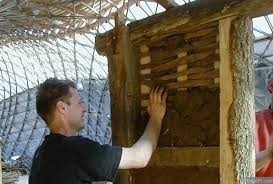

daub
音标:
英音/ dɔːb / 美音/ dɔːb /
听听基本释意:
外刊例句:
Tractors and lorries blocked the A7 motorway in south-east France, with the slogan “we’re dying to feed you” daubed in red on one of the vehicles.
拖拉机和卡车堵塞了法国东南部的 A7 高速公路,其中一辆车上涂着红色标语“我们非常想养活你”。
—BBC
An MP who abstained on the Gaza vote has had her office daubed in red paint by protesters who accused her of having “blood” on her hands.
一名在加沙投票中投弃权票的议员的办公室被抗议者涂上红色油漆,抗议者指责她手上有“血”。
—BBC
Petrol bombs were thrown at a Berlin Jewish community centre and Jewish-owned homes have been daubed with slogans.
柏林犹太人社区中心被投掷汽油弹,犹太人拥有的房屋被涂上标语。
—BBC
基本释意:
noun
an unskillful painting
(随意)涂抹(厚重或粘稠物质);弄脏;乱画
同义词:
没有找到同义词
短释义:
Daub can be used as a verb or as a noun, and is derived from the Old French debaur which comes from the Latin dealbare “to whiten.” It is also used to describe the process of covering a surface with an adhesive substance such as plaster, mud or grease. However, in its noun form, it means a smear of something. When you are ordering “a bagel with a smear,” you could impress the guy at the deli by asking for “a daub” instead.
每当你在表面上涂抹一些东西时,你就在涂抹。抽象表现主义者也许能够在画布上涂上颜料并以数百万美元的价格出售,但你可能不会那么幸运。
长释义:
Daub can be used as a verb or as a noun, and is derived from the Old French debaur which comes from the Latin dealbare “to whiten.” It is also used to describe the process of covering a surface with an adhesive substance such as plaster, mud or grease. However, in its noun form, it means a smear of something. When you are ordering “a bagel with a smear,” you could impress the guy at the deli by asking for “a daub” instead.
Daub 可以用作动词或名词,源自古法语 debaur,它源自拉丁语 dealbare“美白”。它还用于描述用石膏、泥土或油脂等粘合物质覆盖表面的过程。然而,在其名词形式中,它的意思是某物的污点。当你点“带有涂抹的百吉饼”时,你可以通过要求“涂抹”来给熟食店的伙计留下深刻印象。
文学例句:
So many weeks we spent cutting trees, splitting clapboard, tying thatch, making wattle and daub.
我们花了好几个星期砍树、劈开隔板、绑茅草、制作荆条和涂抹。
—Blood on the River by Elisa Carbone
The wattle and daub cottages nearly always got burned, and had to be rebuilt afterwards with much profanity.
那些用篱笆和灰泥砌成的小屋几乎总是被烧毁,之后不得不以极大的亵渎来重建。
—The Once and Future King by T. H. White
Manet tore a piece of bread in half and daubed butter onto it.
马奈将一块面包撕成两半,并在上面涂上黄油。
—The Name of the Wind by Patrick Rothfuss
词源:
daub (v.)late 14c., dauben, “to smear with soft, adhesive matter, to plaster or whitewash a wall” (Dauber as a surname is recorded from mid-13c.), from Old French dauber “to whitewash, plaster” (13c.), perhaps from Latin dealbare, from de-, here probably meaning “thoroughly,” + albare “to whiten,” from albus “white” (see alb).
From 1590s as “to dress or adorn (a person) without style or taste.” Painting sense is from 1620s. Related: Daubed; daubing, daubery. As a noun from mid-15c. as “daubing material, cheap kind of mortar;” 1761 as “inartistic painting.”Related entries & more
下面是词源的翻译(机器翻译比较难翻,参考着看)
daub (v.)late 14c., dauben,“用柔软的粘性物质涂抹,抹灰或粉刷墙壁”(Dauber 作为姓氏从 13 世纪中期开始记录),源自古法语 dauber“粉刷,灰泥” ” (13c.),可能来自拉丁语 dealbare,来自 de-,这里可能表示“彻底”,+ albare“变白”,来自 albus“白色”(参见 alb)。从 1590 年代开始,“没有风格或品味地穿着或装饰(一个人)”。绘画感来自1620年代。相关:涂抹;涂抹,涂抹。从 15 世纪中期开始作为名词。作为“涂抹材料,一种廉价的砂浆”; 1761 年作为“非艺术绘画”。相关条目及更多
本站没有存储任何书籍、杂志和报纸。
页面内容只做展示和推荐。如果您喜欢本期内容请购买正版。
This site does not store any books, magazines or newspapers.
The contents of the pages are for display and recommendation only.
If you like the content of this issue please purchase the original.